As the first consumer electronics show in 2020, CES closed successfully in the middle of this month. In this exhibition, we saw brand new smart cars, folding phones, AI robots, and a variety of future products based on AI and vision technology.
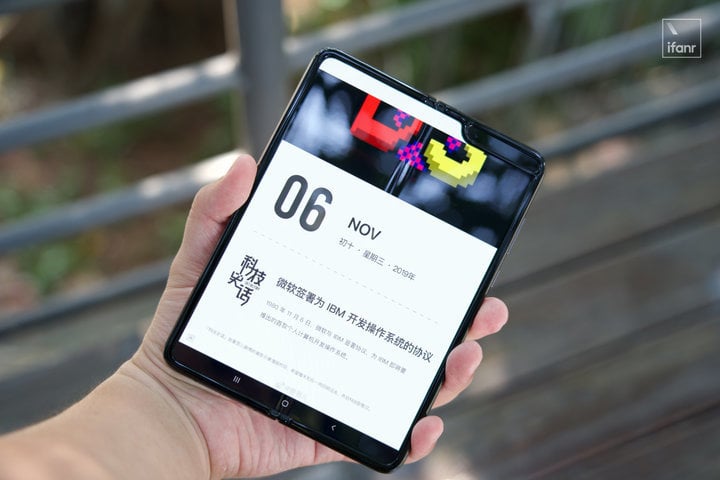
However this year’s CES highlights In addition to the categories mentioned above, I also see that the screen is being used in various Forms penetrate into every life scene and change the way humans and machines display and interact in the future.
As Apple uses The best craftsmanship has created the iPhone XR , and Samsung has used the folded OLED to create the Galaxy Fold. … .. The “screen” as the window of the device, it will play a pivotal role in today’s and future technology products.
creation of a screen
Since the first flexible screen mobile phone was born, we have discussed many screens in technology products so far Creativity. Whether in display technology, materials or size, the screen is constantly changing according to human needs.
In this year’s CES show, I saw companies like Samsung, LG Display (LGD), Sharp Other manufacturers have different applications on the screen-from a distance you may think that it is a wall, a glass, but in fact what you see is what the machine displays.
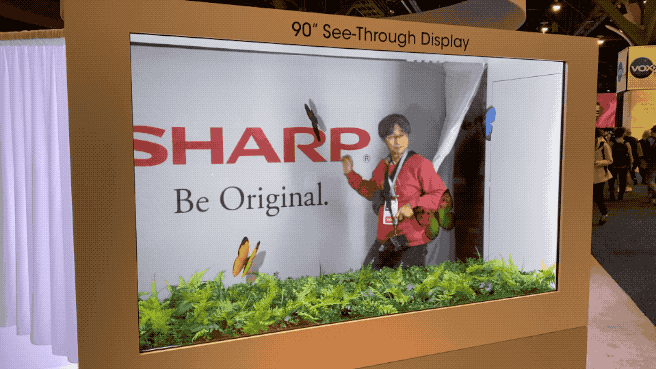
▲ 90-inch transparent screen exhibited by Sharp
Sharp and OLED booths both have transparent OLED displays, and Sharp is still at the booth. A prominent 90-inch transparent OLED “photo frame” is placed at a conspicuous position. From a distance, it looks like AR is added to the glass window, but it is actually more “hardcore” to play the animation directly on the screen.
However, LGD’s solution is more important than Sharp’s use of transparent OLEDs for display. Human-computer interaction.
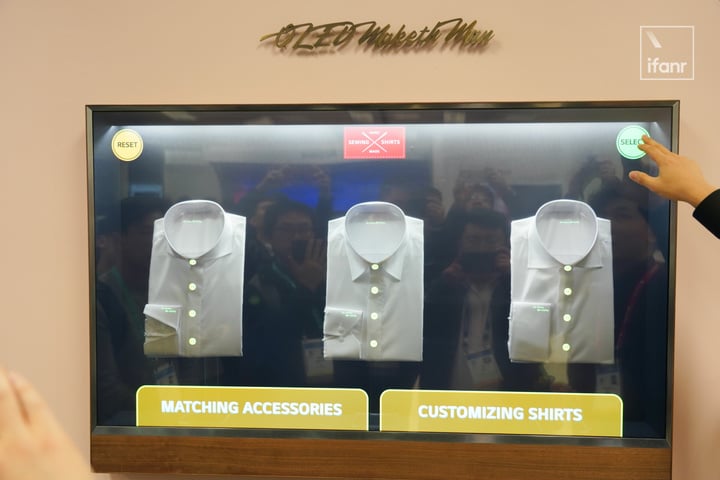
In a showroom full of screens, LGD showed us a window for the future. However, this “window” is not another “window”. The glass of this window is actually an OLED screen. LGD uses in-TOUCH technology on this screen. The touch module is embedded in the panel to make it support touch. Controls and gestures.

In fact, LGD has two screens beside the window. One is a normal screen, and the other is a transparent OLED. However, the two screens are displayed in series. The normal screen displays the background. The transparent OLED acts as a touchpad and feeds back real-time operations to the normal screen for display.
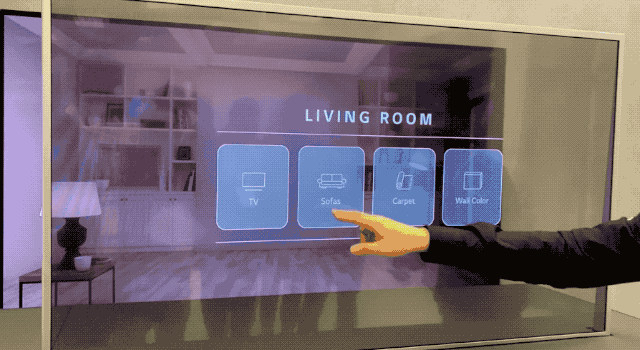
In fact, in addition to the two schemes demonstrated above, the final development direction of transparent OLEDs, I think, is not just big. Screen device can also be applied to future mobile devices-smart watches, glasses, or like “Iron Man” Tony Stark This one Transparent screen phone Same.

Of course, the ideal is full and the reality is skinny. The idea of using transparent OLEDs on mobile phones is cool, but its performance and productivity are still a big issue, and other parts have to be redesigned according to transparent screens, so transparent screen phones may have in the future, but at least they must wait for transparency The display will not be available until it becomes popular elsewhere.
So I focused on the flexible OLED that is more in line with the current development.
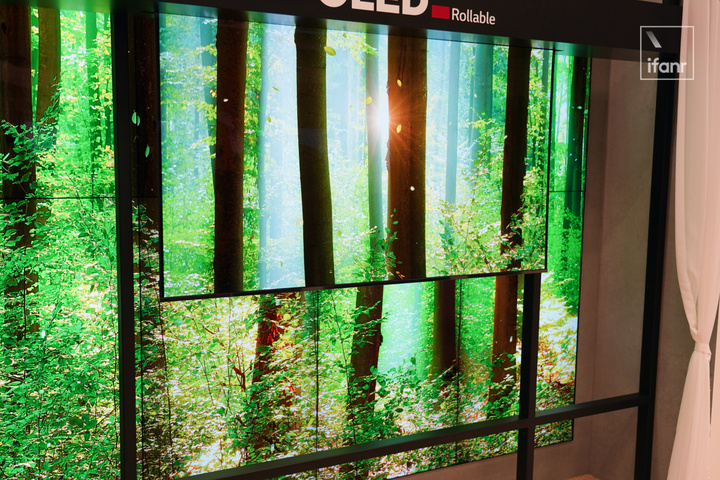
▲ LGD’s Reel TV
I believe that everyone is not unfamiliar today, after all, it is already in mobile phones, displays, TVs The technology has been used for several years, and after continuous improvement and update, flexible screens are quite mature today. At last year’s CES, LGD released the Signature RX reel TV in the upright position, and this year’s LG display samples have become wall-mounted.
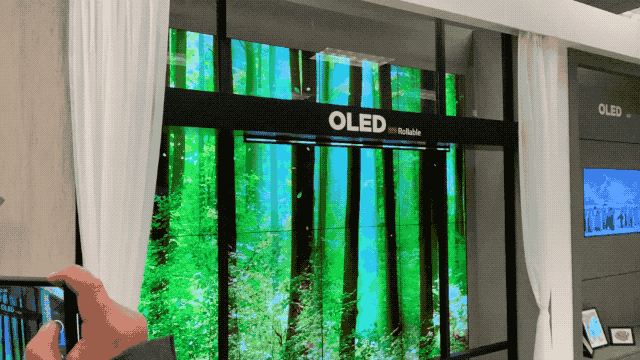
As I said at the Vlog video at the CES site, I ca n’t believe me as I slowly put down the screen In front of him is a TV, “This has gone beyond my understanding of TV. I never thought that TV could be rolled up.”
However, reel TVs have high requirements for OLED and mechanical reels, and they still only appear in today. In the official display, even if there is a finished product on the market, its price will be very high. (rumored to be $ 60,000) .
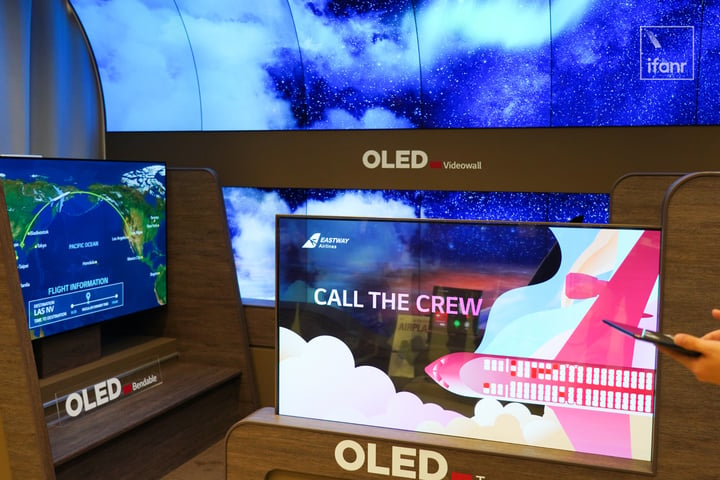
LGD also showed me a “Future First Class” composed of various screens, this OLED flexible screen and transparent screen are used to form the screen wall, control panel, entertainment terminal, privacy bezel to replace the traditional screen use scheme.
It is more interesting that they use a transparent screen as the “window” of the cockpit. It is displayed transparently when it is needed, and it is blocked by a dark picture when it needs to be masked.
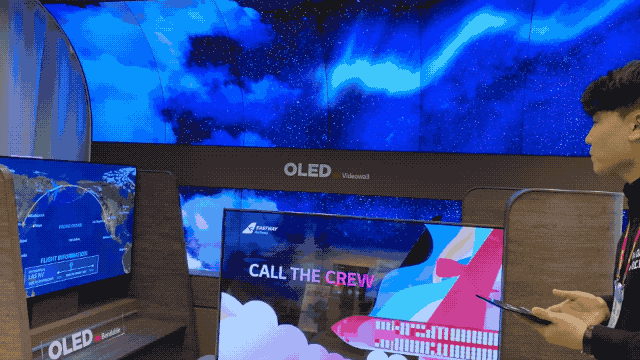
But after all, the material itself is transparent, so the effect is only like the eyes with sunglasses, the outside is still Can see inside the cockpit.
In addition to “Future First Class”, I also saw a cockpit made of POLED and OLED. Program. In simple terms, the screen is used to replace the traditional instruments in the cockpit of the car, and the entire screen (or stitching) is used to replace the display and interaction.
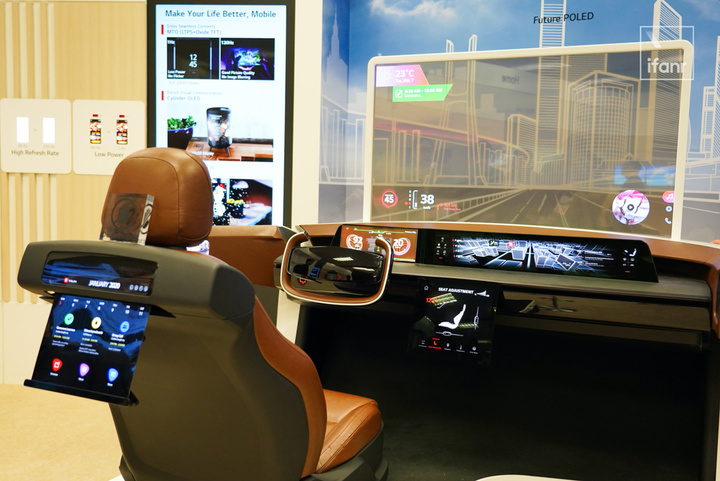
In fact, we can also see the screen in future cars in the Vision S concept car released by Sony at the same time In fact, from the perspective of LGD’s screen manufacturers and Sony’s screen applications, the screen will not only serve as a display in future cars, but also serve as an interactive operation.
We can actually see that car interactions are gradually changing in Tesla and Byton today. It has diversified functions, intelligence, and flat operation.
In the future, this “display + interaction” method will be covered by the screen to The entire cabin.

If LGD’s POLED screen wall brings a visual shock. Then by This contact lens exhibited by Mojo Vision This pair of contact lenses can be said to be a” spiritual shock. ”
I say this because they embedded the screen into contact lenses, and this screen is the smallest screen in the audience. It is based on MicroLED and has a diameter of only 0.48 mm and only one sesame seed. Size, but despite this, its cost reached US $ 108 million.
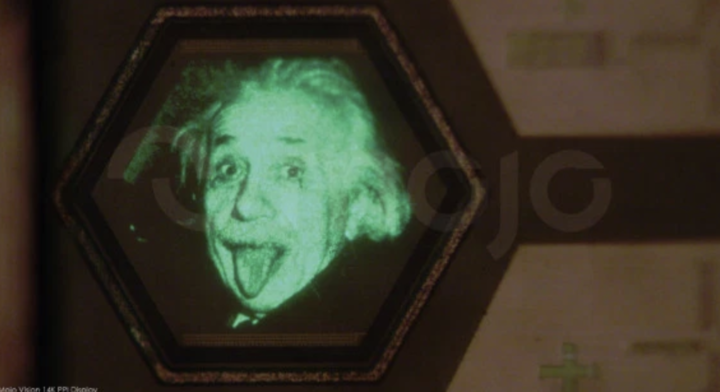
▲ Use the miniature screen to view Einstein’s tongue map. Picture from: Venturebeat
In terms of function, this screen is mainly used to provide AR screen display for visually impaired people. Detection of the environment by contact lenses, AR can help visually impaired people to live better independently by enhancing the contrast of objects.
In future applications, this contact lens can also be used for AR interaction and information display, Become an external part to strengthen human organs.
Micro LED makes screen bigger and brighter, OLED needs to change physical interaction
We can see that the role of the screen will become more and more important in the future through devices of different forms and uses. In addition, the screen also Considering the use of replacing the traditional control panel. In the future, the screen can appear in various forms of devices, and the screen itself has gradually begun to develop into a flexible and polymorphic.
In this CES, I divided the future screen application trends into three types: one is OLEDs that are already in use today, the other two are POLEDs and Micro LEDs that have been used in concept products.
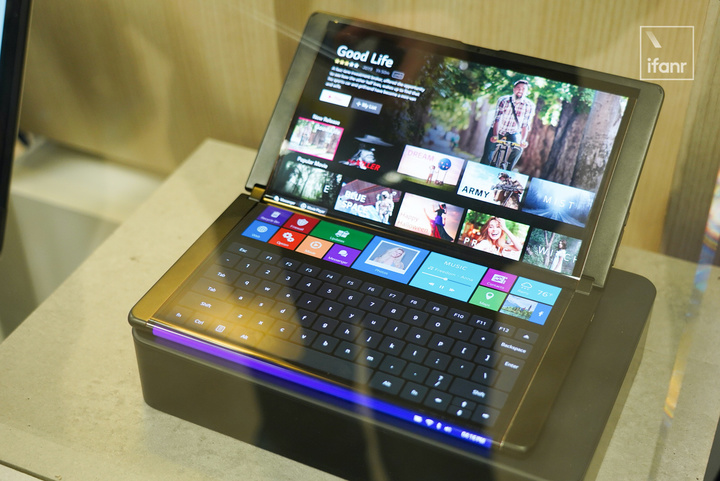
OLED has been applied to mobile phones, TVs and other devices today, and it has better light transmission At the same time, it can also be bent according to the form of the device. From today’s CES, OLED will continue to be the main material for electronic device panels in the next 1-2 years.
In LGD’s booth, I saw a folding mobile phone solution with a combination of a folding screen and a flexible screen. But rather than a cell phone, I think this is a “pocket computer” role.
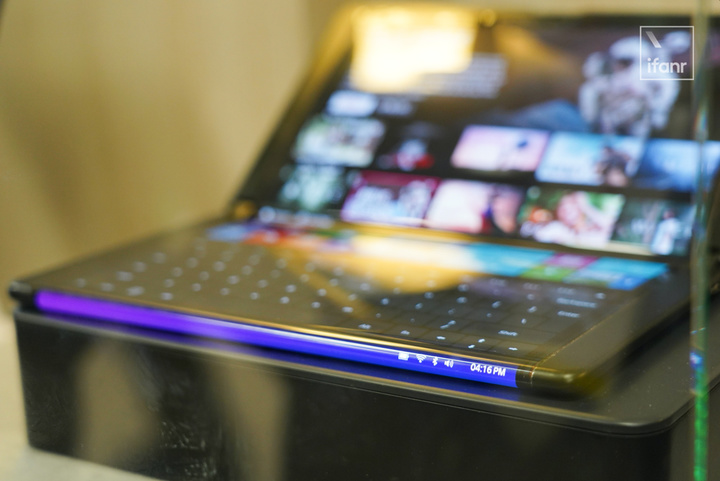
This device has no B / C aspect, because it is a whole flexible OLED screen The UI layout of the system will change with the gravity sensing of the device. You can put your hands on the virtual keyboard to type, and you can also use two screens to display. The hinge part is used as a shortcut bar like MacBook TouchBar. The upper and lower areas are separated.
I also noticed that there is a flexible screen with a large curvature at the edge of the lower screen. This screen shows Device status bar, but I would likeIf you can put a small window on the edge screen like Windows, the efficiency of this “pocket computer” will be greatly improved.
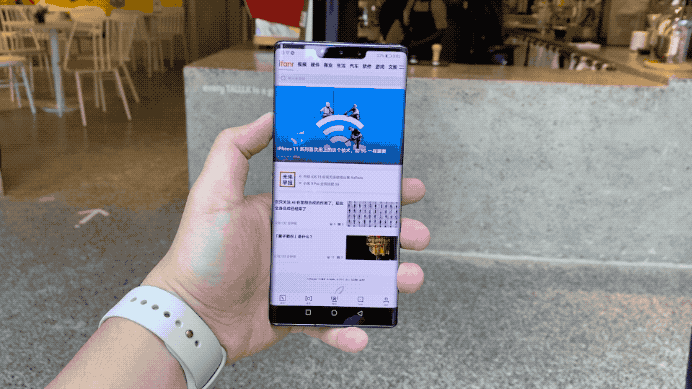
▲ Huawei Mate30 Pro uses curved screen instead of volume key interaction
In fact, there are many products that change the traditional interaction based on OLED, such as Huawei and vivo. The use of screens last year reduced the precedent for cell openings. In terms of touch interaction replacing traditional interaction, screen manufacturers are using softer POLEDs as panels for large-sized devices.
As mentioned earlier, car control panels are becoming “touchable”, and here you must not Not to mention the new screen like POLED.
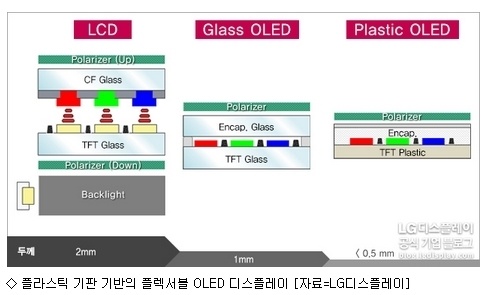
▲ Comparison of LCD, OLED, and POLED structure
The full name of POLED is Plastic OLED. As the name suggests, the substrate of this OLED is changed from OLED glass to Plastic, so the screen is about 30% thinner and lighter than OLED. Thanks to the toughness of plastic materials, POLED is relatively more flexible than OLED. It can be said that touch is the most suitable material to replace traditional interaction.

The central control panel shown by LGD is a splicing of POLED and OLED. The POLED part extends from the dashboard to the entire center console. The entire control panel consists of multiple T-shaped screens.
These screens allow the driver to adjust the state of the car at will.
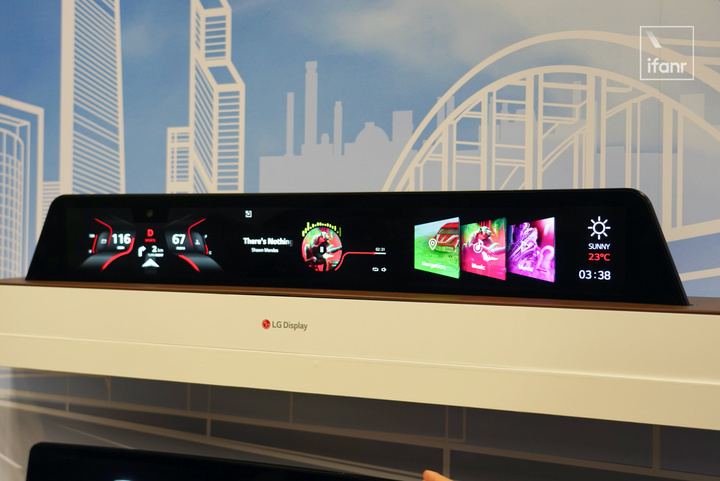
▲ The dashboard of the future car is made of OLED and POLED.
However, the plastic substrate used by POLED cannot bring the same scratch resistance and touch feeling as OLED, This makes POLEDs still very limited in real-life scenarios. Although this fabric is the best choice for folding and bending equipment, no one likes non-durable products.

previous Moto The Razr phone announced by rola uses POLED. This phone is called “the most perfect folding screen phone”, but just like last year’s first Folding screen phone Samsung Galaxy Fold, the performance of POLED still need to wait for Razr’s debut before we can have an answer.
Compared with the previous two types of OLEDs, the long-sounding Micro LED is more focused on display performance. < / span>

Samsung ’s “The Wall” display wall at the CES booth is a demonstration of the quality of MicroLED, Color quality and seamless splicing advantages, and on this basis, Samsung is merging with home via bezel-less TV. It is an excellent large-screen TV and also a 292-inch “view window” at home.
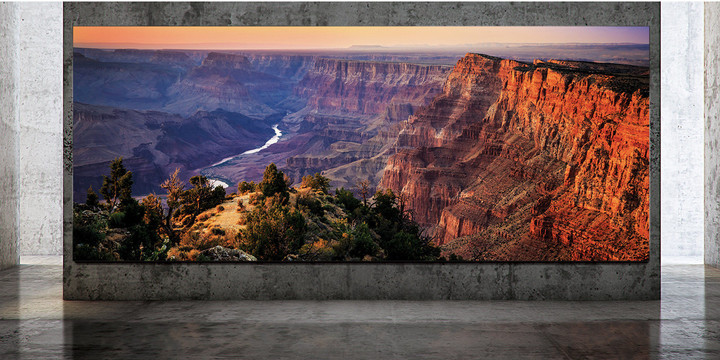
Compared with traditional LCD and OLED screens, Micro LED has many advantages, except for the normal PPI pixel value In addition to high brightness, high brightness, and many backlight partitions, its service life and energy efficiency performance are the best of the three.
But the shortcomings of Micro LED are also obvious, although Samsung has announced that it has mass-produced Micro LED Preparation, but this process requires high-quality, low-yield screens can not be applied to mass-produced consumer electronics in the short term. Moreover, the cost of 3-4 times more expensive than the OLED of the same specification has also become a major obstacle to the popularity of Micro LED.
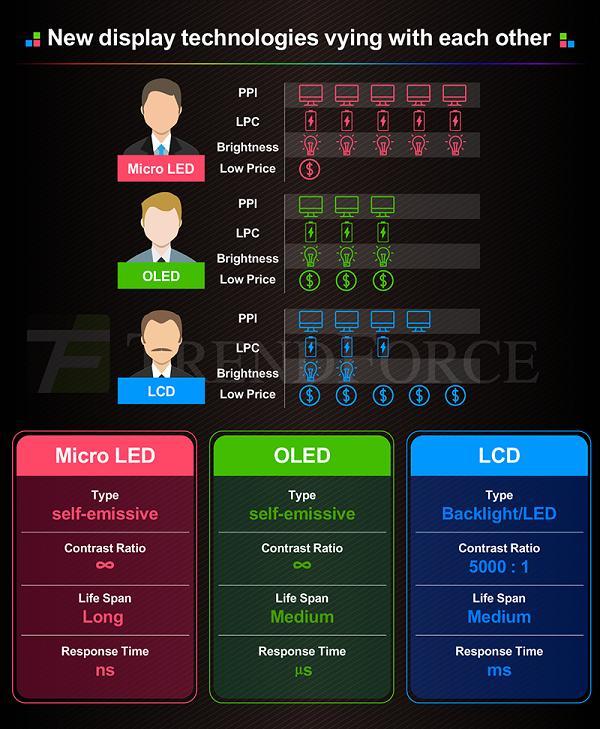
▲ Micro LED, OLED, LCD screenComparison of advantages and disadvantages of the curtain
Therefore, the industry is looking for Micro LED as the goal, looking for more ways to increase the screen capacity, and here During this period, the display level is close to Micro LED, Mini LED with cost similar to OLED .
Future-oriented display technology
The role of the screen has gradually changed from the display to the role of “display + control”, screen manufacturers The competition has also expanded from research and development technology to product applications. For manufacturers who already have mature product systems, screen manufacturers provide more advanced display technologies to change product performance and form.
At the same time, screen makers are pushing for more innovative applications to improve products and Brand sales and market position in the next ten years.

▲ OPPO under-camera design
From the perspective of small-sized screen devices such as mobile phones and watches, plastic OLEDs will still be consumption this year. The main screen material for electronic devices. This point of view comes from the deformation of the mobile phone screen and the dependence of the under-screen sensor technology on the screen. The high light transmission and foldable characteristics of OLED make it the best choice for new forms of mobile phones.
The current OLED market pattern is mainly divided into two aspects. On the one hand, Samsung, as the world’s largest OLED producers association, Continue to occupy the market share, maintaining its share at 80-90%; on the other hand, domestic OLED manufacturers such as BOE are trying to catch up. As the demand for domestic mobile phones for OLEDs increases, domestic small-sized OLED shipments It is also expected to increase.

From the perspective of large-sized products, OLED will also be the main material for new interactions, such as smart TVs. Large-scale products such as cars, elevators, and elevators will use screens to replace traditional interactions, and more flexible POLEDs will also be used in To B areas, such as large exhibition wall paintings.

▲ POLED screen wall on LGD’s booth
But despite this, Samsung will still have exclusive advantages in OLED production capacity in the next few years, such as evaporation Machines (production applications), metal masks, and super-invar tiles (which affect screen display accuracy and yield) are supplied exclusively to Samsung by several manufacturers such as Hitachi, and other manufacturers can only get a very small amount of resources. Therefore, although domestic manufacturers have broken through the difficulties in OLED manufacturers, The industry” second “BOE is still a long way from” boss “ .
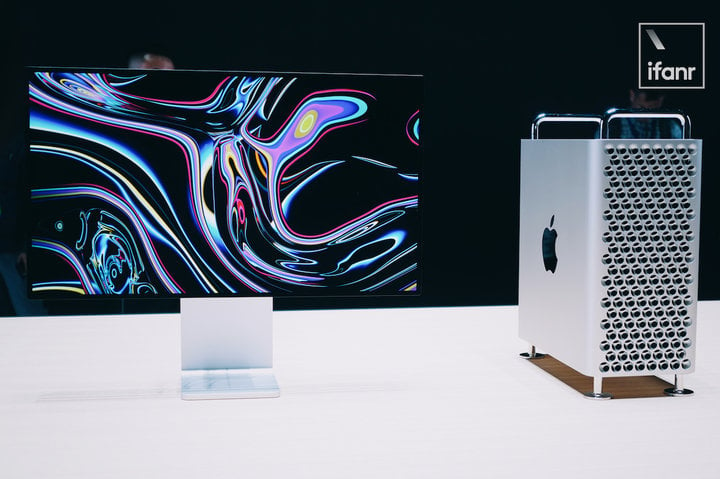
▲ Apple Pro Display XDR display uses top LED screen
The role of Micro LED is more like the ideal that everyone is pursuing. It is almost perfect, but it is also far away. and. This new panel with long service life, high response, excellent display quality and low cost of use will be the final upgrade form of the screen in the next ten years. However, the extremely high process requirements can only allow such panels to exist in the market in a small amount at present. Manufacturers still need time and materials to break through The production difficulties of Micro LED .
But I believe that at the next two years of CES, we will see more based on Micro LED Concept product. Before that, we may wish to focus on Mini LED, it will be the most suitable transition solution from OLED to Micro LED.

▲ 90-inch transparent screen exhibited by Sharp
Sharp and OLED booths both have transparent OLED displays, and Sharp is still at the booth. A prominent 90-inch transparent OLED “photo frame” is placed at a conspicuous position. From a distance, it looks like AR is added to the glass window, but it is actually more “hardcore” to play the animation directly on the screen.
However, LGD’s solution is more important than Sharp’s use of transparent OLEDs for display. Human-computer interaction.

In a showroom full of screens, LGD showed us a window for the future. However, this “window” is not another “window”. The glass of this window is actually an OLED screen. LGD uses in-TOUCH technology on this screen. The touch module is embedded in the panel to make it support touch. Controls and gestures.

In fact, LGD has two screens beside the window. One is a normal screen, and the other is a transparent OLED. However, the two screens are displayed in series. The normal screen displays the background. The transparent OLED acts as a touchpad and feeds back real-time operations to the normal screen for display.

In fact, in addition to the two schemes demonstrated above, the final development direction of transparent OLEDs, I think, is not just big. Screen device can also be applied to future mobile devices-smart watches, glasses, or like “Iron Man” Tony Stark This one Transparent screen phone Same.

Of course, the ideal is full and the reality is skinny. The idea of using transparent OLEDs on mobile phones is cool, but its performance and productivity are still a big issue, and other parts have to be redesigned according to transparent screens, so transparent screen phones may have in the future, but at least they must wait for transparency The display will not be available until it becomes popular elsewhere.
So I focused on the flexible OLED that is more in line with the current development.

▲ LGD’s Reel TV
I believe that everyone is not unfamiliar today, after all, it is already in mobile phones, displays, TVs The technology has been used for several years, and after continuous improvement and update, flexible screens are quite mature today. At last year’s CES, LGD released the Signature RX reel TV in the upright position, and this year’s LG display samples have become wall-mounted.

As I said at the Vlog video at the CES site, I ca n’t believe me as I slowly put down the screen In front of him is a TV, “This has gone beyond my understanding of TV. I never thought that TV could be rolled up.”
However, reel TVs have high requirements for OLED and mechanical reels, and they still only appear in today. In the official display, even if there is a finished product on the market, its price will be very high. (rumored to be $ 60,000) .

LGD also showed me a “Future First Class” composed of various screens, this OLED flexible screen and transparent screen are used to form the screen wall, control panel, entertainment terminal, privacy bezel to replace the traditional screen use scheme.
It is more interesting that they use a transparent screen as the “window” of the cockpit. It is displayed transparently when it is needed, and it is blocked by a dark picture when it needs to be masked.

But after all, the material itself is transparent, so the effect is only like the eyes with sunglasses, the outside is still Can see inside the cockpit.
In addition to “Future First Class”, I also saw a cockpit made of POLED and OLED. Program. In simple terms, the screen is used to replace the traditional instruments in the cockpit of the car, and the entire screen (or stitching) is used to replace the display and interaction.

In fact, we can also see the screen in future cars in the Vision S concept car released by Sony at the same time In fact, from the perspective of LGD’s screen manufacturers and Sony’s screen applications, the screen will not only serve as a display in future cars, but also serve as an interactive operation.
We can actually see that car interactions are gradually changing in Tesla and Byton today. It has diversified functions, intelligence, and flat operation.
In the future, this “display + interaction” method will be covered by the screen to The entire cabin.

If LGD’s POLED screen wall brings a visual shock. Then by This contact lens exhibited by Mojo Vision This pair of contact lenses can be said to be a” spiritual shock. ”
I say this because they embedded the screen into contact lenses, and this screen is the smallest screen in the audience. It is based on MicroLED and has a diameter of only 0.48 mm and only one sesame seed. Size, but despite this, its cost reached US $ 108 million.

▲ Use the miniature screen to view Einstein’s tongue map. Picture from: Venturebeat
In terms of function, this screen is mainly used to provide AR screen display for visually impaired people. Detection of the environment by contact lenses, AR can help visually impaired people to live better independently by enhancing the contrast of objects.
In future applications, this contact lens can also be used for AR interaction and information display, Become an external part to strengthen human organs.
Micro LED makes screen bigger and brighter, OLED needs to change physical interaction
We can see that the role of the screen will become more and more important in the future through devices of different forms and uses. In addition, the screen also Considering the use of replacing the traditional control panel. In the future, the screen can appear in various forms of devices, and the screen itself has gradually begun to develop into a flexible and polymorphic.
In this CES, I divided the future screen application trends into three types: one is OLEDs that are already in use today, the other two are POLEDs and Micro LEDs that have been used in concept products.

OLED has been applied to mobile phones, TVs and other devices today, and it has better light transmission At the same time, it can also be bent according to the form of the device. From today’s CES, OLED will continue to be the main material for electronic device panels in the next 1-2 years.
In LGD’s booth, I saw a folding mobile phone solution with a combination of a folding screen and a flexible screen. But rather than a cell phone, I think this is a “pocket computer” role.

This device has no B / C aspect, because it is a whole flexible OLED screen The UI layout of the system will change with the gravity sensing of the device. You can put your hands on the virtual keyboard to type, and you can also use two screens to display. The hinge part is used as a shortcut bar like MacBook TouchBar. The upper and lower areas are separated.
I also noticed that there is a flexible screen with a large curvature at the edge of the lower screen. This screen shows Device status bar, but I would likeIf you can put a small window on the edge screen like Windows, the efficiency of this “pocket computer” will be greatly improved.

▲ Huawei Mate30 Pro uses curved screen instead of volume key interaction
In fact, there are many products that change the traditional interaction based on OLED, such as Huawei and vivo. The use of screens last year reduced the precedent for cell openings. In terms of touch interaction replacing traditional interaction, screen manufacturers are using softer POLEDs as panels for large-sized devices.
As mentioned earlier, car control panels are becoming “touchable”, and here you must not Not to mention the new screen like POLED.

▲ Comparison of LCD, OLED, and POLED structure
The full name of POLED is Plastic OLED. As the name suggests, the substrate of this OLED is changed from OLED glass to Plastic, so the screen is about 30% thinner and lighter than OLED. Thanks to the toughness of plastic materials, POLED is relatively more flexible than OLED. It can be said that touch is the most suitable material to replace traditional interaction.

The central control panel shown by LGD is a splicing of POLED and OLED. The POLED part extends from the dashboard to the entire center console. The entire control panel consists of multiple T-shaped screens.
These screens allow the driver to adjust the state of the car at will.

▲ The dashboard of the future car is made of OLED and POLED.
However, the plastic substrate used by POLED cannot bring the same scratch resistance and touch feeling as OLED, This makes POLEDs still very limited in real-life scenarios. Although this fabric is the best choice for folding and bending equipment, no one likes non-durable products.

previous Moto The Razr phone announced by rola uses POLED. This phone is called “the most perfect folding screen phone”, but just like last year’s first Folding screen phone Samsung Galaxy Fold, the performance of POLED still need to wait for Razr’s debut before we can have an answer.
Compared with the previous two types of OLEDs, the long-sounding Micro LED is more focused on display performance. < / span>

Samsung ’s “The Wall” display wall at the CES booth is a demonstration of the quality of MicroLED, Color quality and seamless splicing advantages, and on this basis, Samsung is merging with home via bezel-less TV. It is an excellent large-screen TV and also a 292-inch “view window” at home.

Compared with traditional LCD and OLED screens, Micro LED has many advantages, except for the normal PPI pixel value In addition to high brightness, high brightness, and many backlight partitions, its service life and energy efficiency performance are the best of the three.
But the shortcomings of Micro LED are also obvious, although Samsung has announced that it has mass-produced Micro LED Preparation, but this process requires high-quality, low-yield screens can not be applied to mass-produced consumer electronics in the short term. Moreover, the cost of 3-4 times more expensive than the OLED of the same specification has also become a major obstacle to the popularity of Micro LED.

▲ Micro LED, OLED, LCD screenComparison of advantages and disadvantages of the curtain
Therefore, the industry is looking for Micro LED as the goal, looking for more ways to increase the screen capacity, and here During this period, the display level is close to Micro LED, Mini LED with cost similar to OLED .
Future-oriented display technology
The role of the screen has gradually changed from the display to the role of “display + control”, screen manufacturers The competition has also expanded from research and development technology to product applications. For manufacturers who already have mature product systems, screen manufacturers provide more advanced display technologies to change product performance and form.
At the same time, screen makers are pushing for more innovative applications to improve products and Brand sales and market position in the next ten years.

▲ OPPO under-camera design
From the perspective of small-sized screen devices such as mobile phones and watches, plastic OLEDs will still be consumption this year. The main screen material for electronic devices. This point of view comes from the deformation of the mobile phone screen and the dependence of the under-screen sensor technology on the screen. The high light transmission and foldable characteristics of OLED make it the best choice for new forms of mobile phones.
The current OLED market pattern is mainly divided into two aspects. On the one hand, Samsung, as the world’s largest OLED producers association, Continue to occupy the market share, maintaining its share at 80-90%; on the other hand, domestic OLED manufacturers such as BOE are trying to catch up. As the demand for domestic mobile phones for OLEDs increases, domestic small-sized OLED shipments It is also expected to increase.

From the perspective of large-sized products, OLED will also be the main material for new interactions, such as smart TVs. Large-scale products such as cars, elevators, and elevators will use screens to replace traditional interactions, and more flexible POLEDs will also be used in To B areas, such as large exhibition wall paintings.

▲ POLED screen wall on LGD’s booth
But despite this, Samsung will still have exclusive advantages in OLED production capacity in the next few years, such as evaporation Machines (production applications), metal masks, and super-invar tiles (which affect screen display accuracy and yield) are supplied exclusively to Samsung by several manufacturers such as Hitachi, and other manufacturers can only get a very small amount of resources. Therefore, although domestic manufacturers have broken through the difficulties in OLED manufacturers, The industry” second “BOE is still a long way from” boss “ .

▲ Apple Pro Display XDR display uses top LED screen
The role of Micro LED is more like the ideal that everyone is pursuing. It is almost perfect, but it is also far away. and. This new panel with long service life, high response, excellent display quality and low cost of use will be the final upgrade form of the screen in the next ten years. However, the extremely high process requirements can only allow such panels to exist in the market in a small amount at present. Manufacturers still need time and materials to break through The production difficulties of Micro LED .
But I believe that at the next two years of CES, we will see more based on Micro LED Concept product. Before that, we may wish to focus on Mini LED, it will be the most suitable transition solution from OLED to Micro LED.



▲ Huawei Mate30 Pro uses curved screen instead of volume key interaction
In fact, there are many products that change the traditional interaction based on OLED, such as Huawei and vivo. The use of screens last year reduced the precedent for cell openings. In terms of touch interaction replacing traditional interaction, screen manufacturers are using softer POLEDs as panels for large-sized devices.
As mentioned earlier, car control panels are becoming “touchable”, and here you must not Not to mention the new screen like POLED.

▲ Comparison of LCD, OLED, and POLED structure
The full name of POLED is Plastic OLED. As the name suggests, the substrate of this OLED is changed from OLED glass to Plastic, so the screen is about 30% thinner and lighter than OLED. Thanks to the toughness of plastic materials, POLED is relatively more flexible than OLED. It can be said that touch is the most suitable material to replace traditional interaction.

The central control panel shown by LGD is a splicing of POLED and OLED. The POLED part extends from the dashboard to the entire center console. The entire control panel consists of multiple T-shaped screens.
These screens allow the driver to adjust the state of the car at will.

▲ The dashboard of the future car is made of OLED and POLED.
However, the plastic substrate used by POLED cannot bring the same scratch resistance and touch feeling as OLED, This makes POLEDs still very limited in real-life scenarios. Although this fabric is the best choice for folding and bending equipment, no one likes non-durable products.

previous Moto The Razr phone announced by rola uses POLED. This phone is called “the most perfect folding screen phone”, but just like last year’s first Folding screen phone Samsung Galaxy Fold, the performance of POLED still need to wait for Razr’s debut before we can have an answer.
Compared with the previous two types of OLEDs, the long-sounding Micro LED is more focused on display performance. < / span>

Samsung ’s “The Wall” display wall at the CES booth is a demonstration of the quality of MicroLED, Color quality and seamless splicing advantages, and on this basis, Samsung is merging with home via bezel-less TV. It is an excellent large-screen TV and also a 292-inch “view window” at home.

Compared with traditional LCD and OLED screens, Micro LED has many advantages, except for the normal PPI pixel value In addition to high brightness, high brightness, and many backlight partitions, its service life and energy efficiency performance are the best of the three.
But the shortcomings of Micro LED are also obvious, although Samsung has announced that it has mass-produced Micro LED Preparation, but this process requires high-quality, low-yield screens can not be applied to mass-produced consumer electronics in the short term. Moreover, the cost of 3-4 times more expensive than the OLED of the same specification has also become a major obstacle to the popularity of Micro LED.

▲ Micro LED, OLED, LCD screenComparison of advantages and disadvantages of the curtain
Therefore, the industry is looking for Micro LED as the goal, looking for more ways to increase the screen capacity, and here During this period, the display level is close to Micro LED, Mini LED with cost similar to OLED .
Future-oriented display technology
The role of the screen has gradually changed from the display to the role of “display + control”, screen manufacturers The competition has also expanded from research and development technology to product applications. For manufacturers who already have mature product systems, screen manufacturers provide more advanced display technologies to change product performance and form.
At the same time, screen makers are pushing for more innovative applications to improve products and Brand sales and market position in the next ten years.

▲ OPPO under-camera design
From the perspective of small-sized screen devices such as mobile phones and watches, plastic OLEDs will still be consumption this year. The main screen material for electronic devices. This point of view comes from the deformation of the mobile phone screen and the dependence of the under-screen sensor technology on the screen. The high light transmission and foldable characteristics of OLED make it the best choice for new forms of mobile phones.
The current OLED market pattern is mainly divided into two aspects. On the one hand, Samsung, as the world’s largest OLED producers association, Continue to occupy the market share, maintaining its share at 80-90%; on the other hand, domestic OLED manufacturers such as BOE are trying to catch up. As the demand for domestic mobile phones for OLEDs increases, domestic small-sized OLED shipments It is also expected to increase.

From the perspective of large-sized products, OLED will also be the main material for new interactions, such as smart TVs. Large-scale products such as cars, elevators, and elevators will use screens to replace traditional interactions, and more flexible POLEDs will also be used in To B areas, such as large exhibition wall paintings.

▲ POLED screen wall on LGD’s booth
But despite this, Samsung will still have exclusive advantages in OLED production capacity in the next few years, such as evaporation Machines (production applications), metal masks, and super-invar tiles (which affect screen display accuracy and yield) are supplied exclusively to Samsung by several manufacturers such as Hitachi, and other manufacturers can only get a very small amount of resources. Therefore, although domestic manufacturers have broken through the difficulties in OLED manufacturers, The industry” second “BOE is still a long way from” boss “ .

▲ Apple Pro Display XDR display uses top LED screen
The role of Micro LED is more like the ideal that everyone is pursuing. It is almost perfect, but it is also far away. and. This new panel with long service life, high response, excellent display quality and low cost of use will be the final upgrade form of the screen in the next ten years. However, the extremely high process requirements can only allow such panels to exist in the market in a small amount at present. Manufacturers still need time and materials to break through The production difficulties of Micro LED .
But I believe that at the next two years of CES, we will see more based on Micro LED Concept product. Before that, we may wish to focus on Mini LED, it will be the most suitable transition solution from OLED to Micro LED.

▲ OPPO under-camera design
From the perspective of small-sized screen devices such as mobile phones and watches, plastic OLEDs will still be consumption this year. The main screen material for electronic devices. This point of view comes from the deformation of the mobile phone screen and the dependence of the under-screen sensor technology on the screen. The high light transmission and foldable characteristics of OLED make it the best choice for new forms of mobile phones.
The current OLED market pattern is mainly divided into two aspects. On the one hand, Samsung, as the world’s largest OLED producers association, Continue to occupy the market share, maintaining its share at 80-90%; on the other hand, domestic OLED manufacturers such as BOE are trying to catch up. As the demand for domestic mobile phones for OLEDs increases, domestic small-sized OLED shipments It is also expected to increase.

From the perspective of large-sized products, OLED will also be the main material for new interactions, such as smart TVs. Large-scale products such as cars, elevators, and elevators will use screens to replace traditional interactions, and more flexible POLEDs will also be used in To B areas, such as large exhibition wall paintings.

▲ POLED screen wall on LGD’s booth
But despite this, Samsung will still have exclusive advantages in OLED production capacity in the next few years, such as evaporation Machines (production applications), metal masks, and super-invar tiles (which affect screen display accuracy and yield) are supplied exclusively to Samsung by several manufacturers such as Hitachi, and other manufacturers can only get a very small amount of resources. Therefore, although domestic manufacturers have broken through the difficulties in OLED manufacturers, The industry” second “BOE is still a long way from” boss “

▲ Apple Pro Display XDR display uses top LED screen
The role of Micro LED is more like the ideal that everyone is pursuing. It is almost perfect, but it is also far away. and. This new panel with long service life, high response, excellent display quality and low cost of use will be the final upgrade form of the screen in the next ten years. However, the extremely high process requirements can only allow such panels to exist in the market in a small amount at present. Manufacturers still need time and materials to break through The production difficulties of Micro LED .
But I believe that at the next two years of CES, we will see more based on Micro LED Concept product. Before that, we may wish to focus on Mini LED, it will be the most suitable transition solution from OLED to Micro LED.